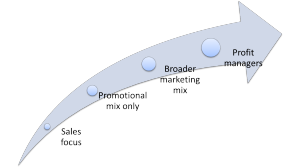Contents
Marketers are becoming profit managers
The marketing profession has certainly evolved and developed over recent years and is significantly different in its role and scope than in the past.
The following diagram, which highlights the progression in the emphasis of a marketing role, summarizes the transition of the marketing role – from sales focused to now becoming perceived as profit managers.
Sales focused
If we go back well in time, then the original role of a marketer was typically as a salesperson. Firms had products to sell and they needed to find and consumers to buy them. “Marketers” were typically involved in selling to retailers, other businesses, and in even door-to-door selling situations.
Promotional mix only
Primarily, with the advent of television in the 1950s and 1960s onwards in most developed countries, businesses realized the potential of mass-market advertising to build their brand and to generate significant ongoing sales through customer loyalty.
At this time the marketing role inside a firm (note: people were still involved in selling) made the transition to being primarily advertising and promotional based. Probably in the 1970s and 1980s a person employed as a professional marketer would generally only have the ability to design the firm’s overall communication and promotional plan. It would be unusual at that time for a marketing role to be much broader than just promotion and advertising in the average company.
The full marketing mix
The next transition is to the broader scope of marketing that we typically learn about the marketing textbooks and when we study marketing at university. From the mid 1980s onwards, it became more common for marketers to control the full scope of the marketing mix. They moved beyond being restricted to just the promotional elements and were also involved in product development and selection, pricing decisions, and setting up new markets and channels.
And in service firms, their marketing reach extended even further into elements of human resources (the people mix), operational design issues (the process mix), and an array of other seemingly unrelated decisions, including the design design stores/buildings, business cards, staff uniforms (the physical evidence components).
This transition was primarily driven by a shift by firms to be more customer – centric and put customer needs at the center of their marketing strategies. Therefore, instead of developing a product first and then trying to find a target market – firms reversed this and consider the needs of the target market first and then tried to develop suitable products to meet the needs of these consumers.
Marketers as profit managers
The current transition in the marketing profession is from a coordinator of the marketing mix to a profit driver and manager for the firm. This means that marketers see their role as increasing the long-term profitability for an organization. Part of this is driven by the increased analytical and scientific nature of marketing. Their tools of the trade – the marketing mix – are just components that allow them to deliver this enhanced profitability.
Corporate culture
While this article highlights the overall trend and transition in the marketing profession for marketers to become the profit drivers for their organizations, it is important to note that different companies operate quite differently. Indeed, it is still possible to find relatively successful companies that still limit their marketing roles to the promotional mix only, whereas other organizations consider marketing to be everybody’s role within the company.

